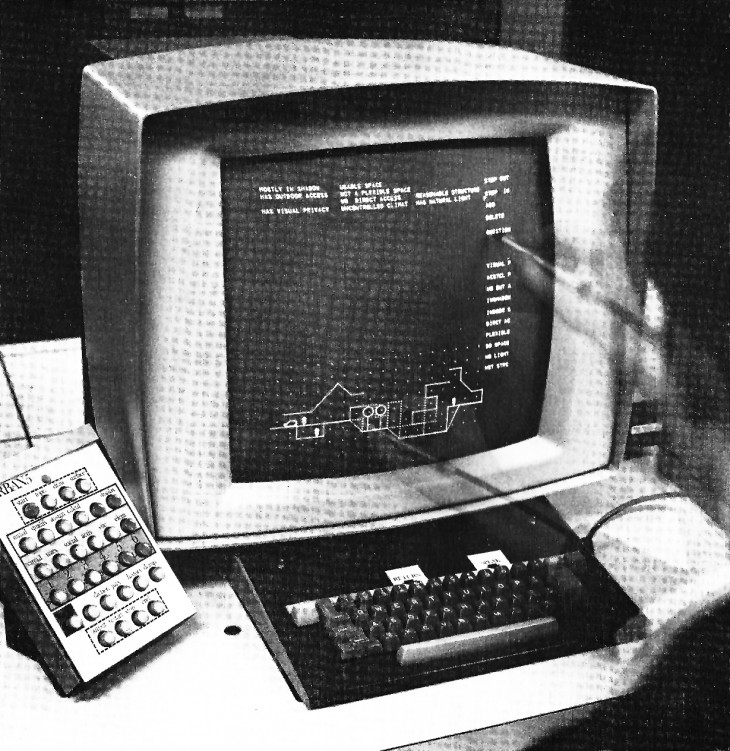March 1969 : the date of publishing this text was the key point for understanding and putting this publication in it’s rightframe . For me this date was even more important than the content itself , Nicholas Negroponte back then gave a vision for the future architecture machine . The ability of the author to predict the future of the dialog between the person and the machine was obvious comparing it to our situation with ” architecture machines ” nowadays .
1969 till now , new technologies were applied , a lot of progress and machinery revolution , but still the structure that theauthor built his vision on is still nearly the same . Hovering from the need of such machines for designers helping them to control large scale and small details problems thatstill a need nowadays and these machines are perfectly doing the job , not to forget what he mentioned about the ability of these machines to learn and progress, the thing we are witnessing nowadays with hundreds of software and plugins shared helping every one of us fixing the problem he’s facing and even giving a full flexibility to update these software and plugins to fit every person’s need .
Talking about the dialog between designer and machine creating a system in one point , and having thousands and millions of similar systems elsewhere on the globe was so important for the author . And the only way to create the global system was to connect all these sub-systems together : this connection was important for the author in three ways , gain more computing power , sharing stored information and communication with other systems . This considered “futuristic vision” back then is completely adopted now not to forget the new technologies but the logic still the same . He spoke about connecting between sub-systems via telephone line : we are using the wireless internet to do the same and who knows in the upcoming years which new technology were going to adopt in order to enhance this connection .This connection will allow sharing problems and solutions between different sub-systems and that’s what literally happening now : millions of tutorials , plugins scripts , sources shared all over the world and available for all of us . Not to forget the computing power that developed enormously last ten years allowing the emergence of hundreds of complex software and machines able to do nearly everything .
Early in his writing , the author mentioned the application of 5 mechanisms by the architecture machines in order to find solutions for problems . These machines needs three main properties to work on any design problem through the five mechanisms : an event , a manifestation and a representation .
The event is generally visual ( the input from the designer is a drawing that the machine can detect visually ) the manifestation measures the event with the approximate parameter ( frequency , angle of rotation … ) and the representation which is the act of mapping the information into a receptacle that is compatible with the receiving organism’s processing characteristics . Personally , these three properties are the base of the big question that every one of us asks : who is the solution founder ? the teacher or the machine ? in the future who will be the solution founder ? the teacher or the machine ?the teacher will always be a part of the sub-system ? or the machine can fulfill the whole system ?
Nicholas started his writing wondering who should be solution founder in such dialog ? the teacher giving instructions or themachine itself ? and finishing its writing with a huge ( scares me honestly ) futuristic perception : ” given a form , generate the criteria ( generally provided by theteacher ) … learn from the criteria and someday generate new forms .”
The conventional dialog , between teacher and machine , was based on giving the criteria to the machine ( based on sensory interfaces ) which will generate the form , but with all this technology revolution and machine skills development , will this machine have one day the ability todetect forms directly ( from the surrounding environment and the city maybe ) and generate new forms ( without any teacher involvement in the process or monitoring ) after detecting the criteria of this existing form ? .
With this emergent vision , the teacher won’t have any intervention or relation to the system and the machine is the one man show taking decisions and creating new forms ; and the biggest question is ( considering the intense relationship of trust and confidence between men and machine nowadays ) would men accept and confirm machine’s new forms and be a “ voluntary prisoner “ of it’s decisions ( regardless of bad architecture that could be produced )?

Toward a theory in architecture machines is a project of IaaC , Institute for Advanced Architecture of Catalonia developed at Master in Advanced Architecture , in 2015-16 by :
Student :
Michel alAzzi
Faculty :
Maite Bravo